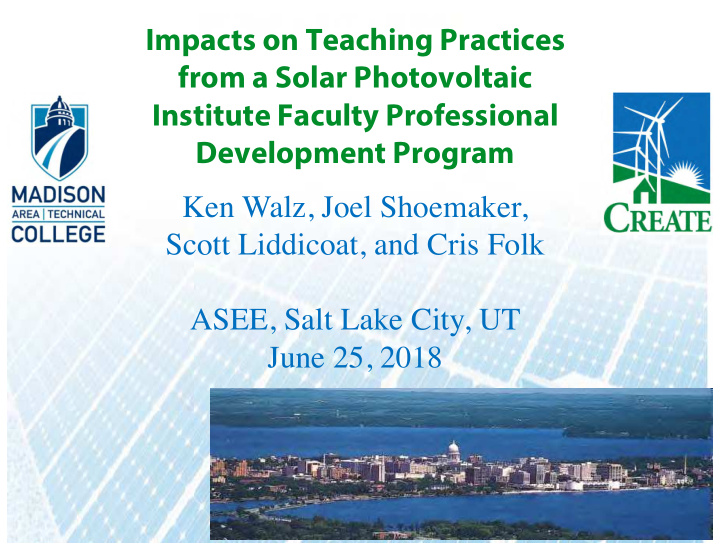



Impacts on Teaching Practices from a Solar Photovoltaic Institute Faculty Professional Development Program Ken Walz, Joel Shoemaker, Scott Liddicoat, and Cris Folk ASEE, Salt Lake City, UT June 25, 2018
global solar PV energy growth 250.0 229 Source: IEA 200.0 179 cumulative installed capacity (GW) Estimated 13.9 GW of solar 150.0 139 PV added in the US in 2016 101 100.0 61 50.0 40 23 16 1.4 1.8 2.2 2.8 3.9 5.3 6.9 9.4 0.0 2000 2001 2002 2003 2004 2005 2006 2007 2008 2009 2010 2011 2012 2013 2014 2015
These are jobs that: 1) Pay a family supporting wage 2) Cannot be outsourced 3) Cannot be done by robots 4) Benefit society
Solar Training and Hiring Insights
Solar Training and Hiring Insights
At the same time, many higher education solar and renewable energy programs struggle to meet enrollment targets. - Many of these programs are very new - Have not had time to market/recruit - The field is still an emerging industry - Prospective students do not have role models - Job market is non-uniform (local/regional hot spots)
The goal of the CREATE Center is to advance the field of renewable energy by supporting two-year college renewable energy programs. This goal will be accomplished through five key objectives: 1) Providing support for faculty 2) Establishing industry, business and academic partnerships. 3) Promoting technician careers 4) Addressing technician knowledge, skills, and competencies 5) Screening, validating, updating, and broadly distributing exemplary renewable energy instructional materials
Faculty Needs Survey Normalized Priority for resources for Solar PV Priority Model Hands-on Student Activities 100 Lab Manuals/Lab Experiments 79 Problem/Project Based Learning Activities 78 Textbooks 68 Video Clips or Narrated Slide Presentations to 50 Support Online or Hybrid Instruction Model Course Syllabi 34 Test Banks, Sample Exams, & Sample 33 Quizzes Homework Problems and Exercises 28 Model Facilities and/or Instructional 26 Laboratory Design Specifications and Plans
Faculty Needs Survey Would you be interested in participating in the following professional development opportunities? (mark all that apply) % participating in 3-5 day summer RE workshops 75 receiving a CREATE newsletter and RE communications 59 participating in online webinars on RE topics/technologies 53 accessing and/or contributing to a showcase of RE teaching materials 48 participating in an online community of RE faculty 46 participating in 1-2 day workshops before or after a conference 35
Building Student Pathways
PV Institute Agenda • Three days • Install a full-size PV system • Small group workshops – Solar pathfinder – Generating an IV curve – PV Watts – Small, battery based system • Student lessons and activities • Discuss implementation within science and technical education curricula
Participant Demographics
Teachers Install Solar PV Systems
Classroom Activities
Measuring Learning Gains 6 Before After 5 # of participants before after Low Score 20.0% 60.0% 4 High Score 90.0% 100.0% 3 Median Score 60.0% 86.7% 2 Mean Score 49.9% 84.4% 1 St Dev 25.7% 12.3% 0 6 8 10 12 14 16 18 20 22 24 26 28 30 # of correct responses (out of 30 questions) How Much Did You Know About Solar Energy? 60 Before PV Institute After PV Institute Percent of Respondants 50 40 30 20 10 0 0 1 2 3 4 5 Nothing A Lot
Impacts on teaching practice Q: Have you used information gained in the Solar Institute to: (mark all that apply ) Answer Choices Responses Educate other staff at your school (colleagues, administrators, etc) 86.1% Enhance classroom lessons 81.0% Modify course curriculum 79.8% Create new lab activities 78.5% Improve or modify existing lab activities 77.2% Add more hands-on learning to the curriculum 57.0% Improve safety procedures and protocols 55.7% Create new course curriculum 51.9% Acquired new lab equipment, supplies, or materials 48.1% Participate in other professional development activities 39.2%
Impacts on student learning improved student attitudes toward renewable energy
Testimonials • “A wonderful experience that will benefit my students. I plan to purchase solar equipment to use in my classroom this year.” • “Really appreciate this opportunity, the material and activities. PV commissioning was a great experience that I can now safely perform in my class.”
What is next? Priority for prof development in energy Normalized topics/technologies Priority Photovoltaics 100 Energy Storage (i.e. Batteries) 79 Energy Management and Building Design 61 Solar Thermal 56 Wind 52 Special Topics 48 Biomass/Biogas 24 Energy Policy 24 Energy/Water Nexus 22 Liquid Bio Fuels (e.g. ethanol & biodiesel) 22 Hydropower 19 International Perspective On Renewable 18 Energy (Study Abroad & Global Literacy) Geothermal 18 CREATE Energy Storage Project – NSF Award # 1800893 (July 1, 2018 - June 30, 2021)
Please Join Us! See our webpage… www.CreateEnergy.org
Take Home Points • Ask teachers what they need • Content knowledge is easy to acquire, but teachers need hands-on professional development • Sharing pedagogy is important • Thoughtful selection of participants builds professional networks and amplifies impact • Provide recognition of efforts (graduate credits, certificate of achievement, press release) • Assessment of impact is invaluable
Thank you for your attention! Questions? This work was supported in part by National Science Foundation Awards #1205015 and 1600934. Any opinions, findings, and conclusions or recommendations expressed in this material are those of the author(s) and do not necessarily reflect the views of the National Science Foundation.
Recommend
More recommend